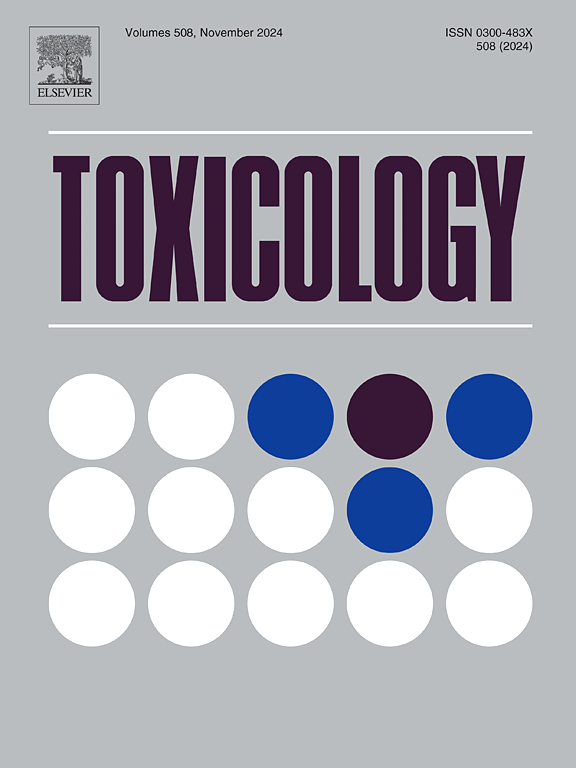Engagement of peroxisome proliferator-activated receptor gamma (PPARγ) and mammalian target of rapamycin (mTOR) in the triclosan-induced disruption of Cyp450 enzyme activity in an in vitro model of mouse embryo fibroblasts (3T3-L1)
IF 4.8
3区 医学
Q1 PHARMACOLOGY & PHARMACY
引用次数: 0
Abstract
Triclosan (TCS) is commonly used worldwide due to its bactericidal and antifungal properties. There are data suggesting the involvement of aryl hydrocarbon receptors (AhR) and peroxisome proliferator-activated receptors (PPARγ). Since the effect of TCS on mouse fibroblasts has not been described so far, we decided to investigate the mechanism of action of this compound in the mouse embryonic fibroblast cell line (3T3-L1). Our results showed that high µM concentrations of TCS increased caspase-3 activity and decreased cell viability after 24-h exposure. The molecular analysis confirmed that 1 µM TCS decreased Ki67 mRNA expression and PCNA protein expression with a similar tendency to that of AhR. The analyses of mRNA levels after treatment with αNF or βNF alone and αNF in combination with TCS showed an increase in Ki67 mRNA expression. TCS alone increased AhR mRNA but had different effects on Cyp1a1 and Cyp1b1 expression. These results suggest the involvement of the PPARγ pathway in the inhibition of Cyp1b1 by TCS. After the TCS exposure, we observed a decrease in PPARγ, and this effect was enhanced in the presence of an AhR agonist and antagonist. These results support the theory about the interaction between the AhR and PPARγ pathways. In the experiments, the strongest increase in PI3K protein expression was observed in the group treated simultaneously with TCS and βNF. Changes in the PI3K level were reflected in changes in the examined mTOR protein. TCS caused a decrease in both mTOR and Cyp1b1 after 24 hours, while opposite effects were observed after 48 hours. Given the crucial role of Cyp1b1, PPARγ, and mTOR in cellular metabolism, we can conclude that TCS is able to disrupt a number of cellular processes. Our data suggest that TCS reduces the metabolism of this xenobiotic in mouse preadipocytes.
在小鼠胚胎成纤维细胞(3T3-L1)体外模型中,过氧化物酶体增殖激活受体γ(PPARγ)和哺乳动物雷帕霉素靶标(mTOR)参与三氯生诱导的 Cyp450 酶活性破坏。
三氯生(TCS)由于其杀菌和抗真菌的特性在世界范围内被广泛使用。有数据表明芳烃受体(AhR)和过氧化物酶体增殖激活受体(PPARγ)参与了这一过程。由于TCS对小鼠成纤维细胞的作用迄今尚未被描述,我们决定研究该化合物在小鼠胚胎成纤维细胞系(3T3-L1)中的作用机制。我们的研究结果表明,高浓度的TCS在暴露24小时后增加了caspase-3活性,降低了细胞活力。分子分析证实,1µM TCS降低Ki67 mRNA表达和PCNA蛋白表达的趋势与AhR相似。α - nf、β - nf单用及α - nf联合TCS处理后,Ki67 mRNA表达升高。单用TCS可增加AhR mRNA的表达,但对Cyp1a1和Cyp1b1表达的影响不同。这些结果表明PPARγ途径参与了TCS对Cyp1b1的抑制。在TCS暴露后,我们观察到PPARγ的减少,并且在AhR激动剂和拮抗剂的存在下这种作用得到增强。这些结果支持了AhR和PPARγ通路相互作用的理论。实验中,在TCS和βNF同时处理组,PI3K蛋白的表达增加最为明显。PI3K水平的变化反映在mTOR蛋白的变化上。TCS在24小时后引起mTOR和Cyp1b1的降低,而在48小时后观察到相反的效果。考虑到Cyp1b1、PPARγ和mTOR在细胞代谢中的关键作用,我们可以得出结论,TCS能够破坏许多细胞过程。我们的数据表明,TCS降低了小鼠前脂肪细胞中这种外源物的代谢。
本文章由计算机程序翻译,如有差异,请以英文原文为准。
求助全文
约1分钟内获得全文
求助全文
来源期刊

Toxicology
医学-毒理学
CiteScore
7.80
自引率
4.40%
发文量
222
审稿时长
23 days
期刊介绍:
Toxicology is an international, peer-reviewed journal that publishes only the highest quality original scientific research and critical reviews describing hypothesis-based investigations into mechanisms of toxicity associated with exposures to xenobiotic chemicals, particularly as it relates to human health. In this respect "mechanisms" is defined on both the macro (e.g. physiological, biological, kinetic, species, sex, etc.) and molecular (genomic, transcriptomic, metabolic, etc.) scale. Emphasis is placed on findings that identify novel hazards and that can be extrapolated to exposures and mechanisms that are relevant to estimating human risk. Toxicology also publishes brief communications, personal commentaries and opinion articles, as well as concise expert reviews on contemporary topics. All research and review articles published in Toxicology are subject to rigorous peer review. Authors are asked to contact the Editor-in-Chief prior to submitting review articles or commentaries for consideration for publication in Toxicology.
 求助内容:
求助内容: 应助结果提醒方式:
应助结果提醒方式:


